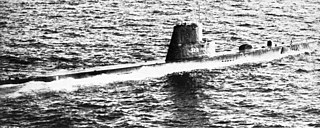
USS Barracuda (SF-4/SS-163), lead ship of her class and first of the "V-boats," was the second ship of the United States Navy to be named for the barracuda.

USS Argonaut (SS-475) was a Tench-class submarine operated by the United States Navy (USN). Constructed at Portsmouth Navy Yard during the second half of 1944, Argonaut was commissioned into the USN in 1945 and operated during the final year of World War II, although her only contact with the Japanese was when she sank a junk in August. During the 1950s, the submarine was modified for greater underwater endurance, and to guide the Regulus I missile. From 1963 to 1965, Argonaut operated in the Mediterranean Sea.
USS Corsair (SS-435), a Tench-class submarine, was the second ship of the United States Navy to be named for the California rockfish, or a pirate or privateer, especially Turkish or Saracen.

USS Cutlass (SS-478), is a Tench-class submarine now in the service of the Republic of China Navy. She was the only ship of the United States Navy to be named for the cutlassfish, a long, thin fish found widely along the coasts of the United States and in the West Indies. Her keel was laid down by the Portsmouth Navy Yard on 10 July 1944. She was launched on 5 November 1944 sponsored by Mrs. R. E. Kintner, and commissioned on 17 March 1945 with Commander Herbert L. Jukes in command.

USS Croaker (SS/SSK/AGSS/IXSS-246), a Gato-class submarine, was the first ship of the United States Navy to be named for the croaker, any of various fishes which make throbbing or drumming noises.

USS Gurnard (SS-254), a Gato-class submarine, was the first ship of the United States Navy to be named for the gurnard.

USS Manta (SS/ESS/AGSS-299), a Balao-class submarine, was the first submarine and second ship of the United States Navy to be named for the manta.

USS Caiman (SS-323), a Balao-class submarine, was a ship of the United States Navy that was later transferred to the Turkish Naval Forces in 1972 under the Security Assistance Program, where she was recommissioned as the third TCG Dumlupınar. She was retired in 1986.

USS Boarfish (SS-327), a Balao-class submarine, was a ship of the United States Navy named for the boarfish, a fish having a projecting hog-like snout.

USS Charr (SS/AGSS-328), a Balao-class submarine, was a ship of the United States Navy named for the charr.

USS Chub (SS-329), a Balao-class submarine, was a ship of the United States Navy named for the chub, a game fish of the Atlantic and Mediterranean. The name is also given locally to a wide variety of American fishes. She was later transferred to Turkey where she served as TCG Gür.

USS Brill (SS-330), a Balao-class submarine, was a ship of the United States Navy in commission from 1944 to 1947. She was named for the brill, a European flatfish.

USS Bumper (SS-333), a Balao-class submarine, was a ship of the United States Navy named for the bumper, a small fish of the North and South Atlantic Ocean.

USS Capitaine (SS/AGSS-336), a Balao-class submarine, was a ship of the United States Navy named for the capitaine, a brilliantly colored fish inhabiting waters of the Atlantic Ocean from North Carolina to Panama.

USS Corporal (SS-346), a Balao-class submarine, was a ship of the United States Navy named for the corporal, an alternate name for the fallfish, found in streams of the eastern United States.

USS Cubera (SS-347), a Balao-class submarine, was a ship of the United States Navy named for the cubera, a large fish of the snapper family found in the West Indies.

USS Cusk (SS/SSG/AGSS-348), a Balao-class submarine of the United States Navy named for the cusk, a large food fish related to the cod.

USS Cobbler (SS-344), a Balao-class submarine, was a ship of the United States Navy named for the cobbler, the killifish of New South Wales.

USS Hammerhead (SS-364), a Gato-class submarine, was the first ship of the United States Navy to be named for the hammerhead shark, a shark found in warm seas with a flattened anterior forward of the gill slits, presenting a hammer-like silhouette when viewed from above.

USS Jallao (SS-368), a Balao-class submarine, was a ship of the United States Navy named for the jallao, a pearl-white haemulonid food fish of the Gulf of Mexico.



















